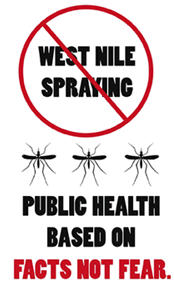 |
Stop West Nile Spraying NowSupport Effective Alternatives to Adulticide Spraying |
|||||||||
|
||||||||||
|
|
||
Murphy's Law of
Pest Control.
|
||
| Study fails to demonstrate that
spraying is effective. A study out of the Harvard School of Public Health in August of 2006 showed that spraying was ineffective in preventing the spread of West Nile virus. How effective is spraying adulticides? "Treating mosquitoes with spray is . . .
analogous to trying to machinegun mosquitoes in flight
as opposed to attacking their life support while they
are relatively fixed in the water. The former is
mathematically difficult to impossible and dangerous.
The latter, while requiring more thinking, is less
dangerous and very effective (as shown by data) . .
. " The dose is so low that there can't possibly be any harm! Or can there? Apparently the argument by vector-control and public-health officials is that even though there is no credible evidence that spraying works, we might as well give it a try since the dose is so low -- just maybe it will work. At best this would be a waste of money and time, but officials are ignoring substantial evidence of risk even at low doses . . . See full text. Since Silent Spring -- got politics? In his book, Since Silent Spring, Frank Graham, Jr., noted that "Rachel Carson has been proved right" and posed the question "What have we done about it?" Peruse these passages and notice some striking similarities with what is going on today relative to West Nile virus. Faith-based vector control? A recent letter to the editor, suggesting that without any scientific evidence to show that adulticiding slows the transmission of WNv to humans, using it as part of a control strategy amounts at best to a matter of faith on the part of SYMVCD. Propaganda
from SYMVCD and CDC?
District Manager David
Brown made this presentation at a CDC conference.
In spite of errors, misrepresentations and false claims
the director of the CDC has refused to remove it from
the website. |
Are there good alternatives to spraying adulticides?A number of locales around the country (e.g. Cheyenne, Boulder, Ft. Worth, and Washington, D.C.) have elected not to spray and have achieved equal or better results than surrounding locales that have sprayed.Have WNv risks been exaggerated and spraying risks largely ignored?As communities around the country have dealt with this issue, some strong statements have been made that suggest that the media and local public-health officials have exaggerated the WNv risk while ignoring very real risks from spraying of adulticides and the ineffectiveness at stopping the transmission of WNv to humans. We list a few of them here.Do these pesticides pose any risks?The U.S. EPA classifies PBO as a Group C-possible carcinogen. Poisonings by the so-called "safe" pesticides are on the rise, and these chemicals are harmful to some people in the short run and pose threats to all of us in the long run by increasing the mutagens in the environment . . . See full text.Our responses to questions vector control officials did not answer.The District was presented with many citizens' questions from public forums, one held by Stop West Nile Spraying Now on 8/22/05 and one officials walked out of in the City chambers on 8/23/05 (see City Forum). The District failed to answer many questions and gave partial, misleading, and factually incorrect answers to others . . . See full textDoes this
protect the public health or is it a
grand hoax?
An op-ed
for the Davis Enterprise on August 13, 2006, suggesting
that the decision to spray Davis was a political one
that had nothing to do with the public health.
|
|
Background textures by GRsites. |
||
